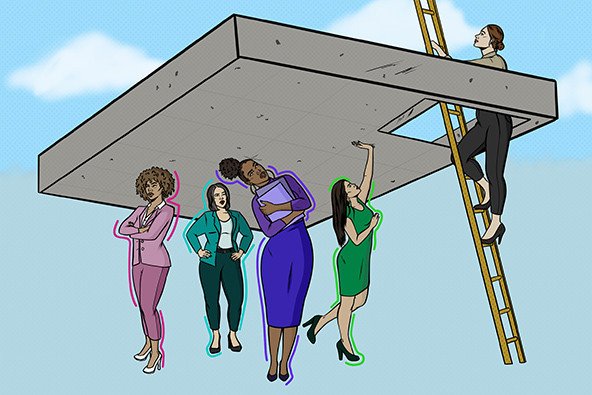Defying the Odds: How Women of Color Can Shatter the Concrete Ceiling
The journey from middle management to the C-suite is a challenging one for any woman, but for women of color in particular, the path is laden with obstacles and may be nearly completely obstructed by the formidable "concrete ceiling." This barrier, rooted in the combined impacts of systemic racism and gender discrimination, is far more complex and resistant than the so-called “glass ceiling” faced by White women. Despite having all the qualifications, experience, and leadership skills to excel in top roles, women of color find themselves underrepresented, overlooked, and–all too often–passed over when the time comes.
This is an injustice that demands urgent attention and concerted corrective action from companies and company leaders.
And although it is not our responsibility as individuals to take on dismantling this concrete ceiling, for WOC who aspire to C-suite and senior leadership roles, we have no choice but to ensure that we make all the right strategic moves, investments, and preparations in order to maximize our chances of success.
So today, let’s dive into the unique challenges faced by women of color leaders in middle management, examine the factors contributing to the concrete ceiling, and provide practical strategies for WOC to break through and claim their rightful place in those corner offices.
The Concrete Ceiling: Understanding the Barriers
The concrete ceiling is a potent metaphor for the compounded discrimination and obstacles that women of color must overcome in their pursuit of career advancement. Unlike the glass ceiling, which implies a transparent barrier that can be easily shattered with persistence and visibility, the concrete ceiling is a more unyielding and opaque structure, reinforced by centuries of systemic racism and deeply ingrained biases.
(A similar set of metaphors relate to the concept of the “double bind” that women in general face, which is frankly more of a “triple bind” for women of color.)
Research consistently reveals the stark underrepresentation of WOC in top leadership positions. A 2023 study by McKinsey & Company found that while women of color comprise 20% of the U.S. population and 17% of the entry-level workforce, they hold a mere 4% of C-suite roles in Fortune 500 companies. This disparity not only highlights the magnitude of the concrete ceiling but also underscores the urgent need for targeted interventions and support systems to help women of color break through.
Intersectional Challenges and Biases
For women of color in middle management, the concrete ceiling is not simply a matter of gender or race alone, but a complex interplay of intersectional identities that shape our lived experiences and career trajectories.
In the workplace, women of color often encounter stereotypes and biases that consistently and insidiously undermine their credibility, competence, and leadership acumen. These biases can manifest in subtle ways, including:
having your ideas dismissed
being passed over for high-profile assignments or promotions, or
being subjected to microaggressions that question your qualifications or culture fit for the company or leadership roles.
All women tend to be tasked with additional administrative and other “caretaking” work in the workplace–even in (sometimes especially in) managerial roles. This has the multifaceted impact of saddling women with lower-value, thankless work, preventing them from spending as much time on outcome-critical work, which then hinders their ability to successfully make the case for their promotion or merit bonuses.
On top of that, women of color are often burdened with the additional expectations of taking on extra race- and gender-based emotional labor, like being the default race/gender representatives for DEI initiatives or being asked to educate their colleagues on issues of race and equity.
The Importance of Representation and Role Models
One of the most significant factors contributing to the concrete ceiling is the lack of representation and visibility of women of color in senior leadership positions.
When women of color do not see themselves reflected in the upper echelons of their organizations, it can be challenging to confidently and convincingly envision their own path to success.
The absence of role models, mentors, and sponsors who understand the unique experiences of WOC and who can provide tailored and applicable guidance and support further compounds the sense of isolation and exclusion.
As women of color ascend the corporate ladder, they may also be feeling an increasing sense of isolation, distance, and exclusion from their family, friends, and community members. They become increasingly isolated “in the middle.”
Moreover, the underrepresentation of women of color in leadership roles perpetuates a cycle of bias and exclusion. When decision-makers and gatekeepers are primarily White and male, they frequently unconsciously gravitate towards candidates who resemble themselves, overlooking the talents and contributions of women of color. This homogeneity in leadership not only reinforces the concrete ceiling but also holds companies back, as the perspectives, contributions, and innovative ideas that WOC leaders bring to the table are essential for success in an increasingly globalized and competitive business landscape.
Strategies for Shattering the Concrete Ceiling
Own your narrative: Women of color must take control of their own stories, increase their visibility, and actively promote their achievements, skills, and leadership acumen. By consistently communicating their value and impact, they build others’ trust in them, which allows them to challenge stereotypes, combat imposter syndrome, and position themselves as top talent in a competitive field. This means being proactive and consistent in seeking out opportunities to showcase their work, such as leading high-profile projects, speaking at conferences, and publishing thought leadership pieces.
Build strategic alliances: Cultivating a strong network of sponsors, mentors, and allies is crucial for women of color to break through the concrete ceiling. Enough of the right people need to be saying their names in rooms they aren’t in, nominating WOC for awards and recognition, connecting them to vital stepping-stone opportunities, and making warm introductions to decision makers in seats of power. So for women of color, seeking out individuals who have successfully navigated similar challenges and can provide guidance, advocacy, and support can help in building the social capital and visibility necessary for advancement. This may involve joining professional organizations, participating in leadership development programs, or actively engaging with senior leaders who can champion their growth. But that alone isn’t enough. We also need to have the strong and robust body of work, the visibility, and the platform to attract enough sponsors and champions to springboard our careers to the final frontier.
Amplify your visibility: Quite relatedly, women of color must be intentional about increasing their visibility within and beyond their companies and industries. At a minimum, this means raising your hand for important growth assignments and opportunities, taking and creating opportunities to demonstrate your leadership skills–preferably cross-functionally in order to maximize visibility, relationship-building and impact, and being seen at industry and networking events. By establishing themselves as experts in their fields and building a strong personal brand, women of color can attract the attention of key decision-makers and influencers who can open doors to new opportunities.
Champion systemic change: As women of color attain senior leadership positions, they have the power and platform to drive systemic change and create a more equitable and inclusive workplace. This involves advocating for diverse hiring and promotion practices, mentoring and sponsoring other underrepresented professionals, and challenging the biases and barriers that perpetuate the concrete ceiling. By leveraging their influence and leading by example, women of color in leadership are uniquely positioned to pave the way for future generations and help dismantle the structures that have historically excluded them.
Invest in your resilience and “career insurance”: Breaking through the concrete ceiling is a marathon, not a sprint, and it requires a deep well of resilience and tenacity. Women of color leaders must learn how to prioritize their mental health and well-being in order to win the “mind game” of climbing the ladder on a daily basis. They must build supportive and diverse networks and invest in their own resources and communities to help them navigate the challenges and setbacks they may encounter along the way. This can include joining affinity groups for WOC leaders, working with a therapist, working with an executive coach, and finding ways to still incorporate joy and balance into their lives. By building and investing in their own “career insurance”–the key valuable relationships and networks, the skills based in resiliency that allow for quick rebounds in times of challenge and duress, the body of work and visibility in the field that allow their reputation to precede them–women of color will maximize their chances of sustaining the stamina, confidence, and determination needed to shatter the concrete ceiling and make it to the C-Suite.
Dismantling the concrete ceiling is an urgent imperative for companies and society as a whole. By making space for women of color to ascend to senior leadership positions, companies will be rewarded with a wealth of talent, valuable perspectives, and key lived experiences that are essential for driving innovation, growth, and social impact in the years and decades to come. But breaking through the concrete ceiling requires an actual investment and coordinated effort on the part of corporate institutions.
On the flip side, women of color in middle management must be proactive in owning their narratives, building strategic alliances, amplifying their visibility, championing systemic change, and investing in their resilience and career insurance.
If nothing else, let the key takeaway from this article be that no single WOC can break through the concrete ceiling on her own. We, especially, need our trusted inner circle and advisors in place, we need our visibility dialed up to the max in order to be visible to and respected by enough of the right people, and we need that career insurance so that when the potholes and trapdoors arise, we can ascend unscathed.



